Want to understand what the "mission of peace" actually means on the ground? Here you'll find clear, practical takes on peacekeeping—how it starts, what it tries to achieve, and where it often runs into trouble. This tag collects articles that cover real missions, human stories, strategies, and lessons learned from global peace operations.
Peacekeeping isn’t just uniforms and patrols. It’s about protecting civilians, supporting local institutions, and creating space for politics to work. When a ceasefire happens, peacekeepers help keep it in place long enough for negotiations and rebuilding to begin. That small window—where violence drops and talks can proceed—is where real change happens.
Think about humanitarian work: peace operations often secure humanitarian corridors so food, medicine, and aid can reach people. They also back local courts, police training, and programs that help communities trust each other again. Those are quiet wins that matter more over time than dramatic headlines.
Most missions combine military, police, and civilian experts. Soldiers provide security, police help restore order, and civilians handle mediation, human rights monitoring, and development support. That mix matters because conflict is rarely just military—it's political, social, and economic.
Technology is changing things too. Drones, data tools, and better communications help teams monitor threats and protect civilians faster. But tech doesn’t replace local knowledge. Successful missions pair tech with people who know the culture and speak the language. That’s why community engagement shows up again and again in the site's stories about effective peacekeeping.
Challenges are real: unclear mandates, limited resources, and political pressure can slow progress. Some articles here look at how peacekeepers adapt—shifting from traditional observation to protecting civilians, or helping rebuild infrastructure after conflict. Others highlight personal accounts from peacekeepers who face danger while trying to build trust with locals.
If you want practical lessons, read pieces that compare missions and extract what worked: clear rules of engagement, strong local partnerships, and fast support for rebuilding services. Community development, when tied to security, reduces the chance of renewed conflict. That’s a repeated theme across the posts tagged "mission of peace."
Curious about human stories? There are features that focus on bravery, resilience, and the small acts that save lives—true accounts that show why many join this work despite the risks. Those narratives help explain the heart of the mission of peace: steady, patient work to protect people and restore normal life.
Use this tag page as a short guide. Read tactical pieces if you want strategies, personal stories if you want perspective, and long-reads for context. The mission of peace isn’t a single action—it's a mix of protection, politics, and people working together to make conflict less likely to return.

As a female writer deeply passionate about world affairs, I have taken it upon myself to pen this insightful post on peacekeeping and its role in nurturing global harmony. Through this article, we'll delve into the crucial tasks peacekeeping operations perform and their undeniable impact in fostering international cooperation. We'll also understand how these missions are pivotal to maintaining world peace and stability. Join me on this enlightening journey as we shed light on the mission for global harmony.
